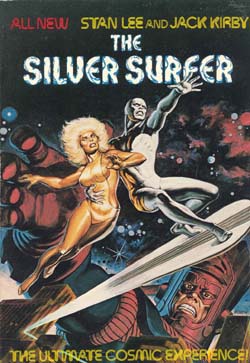 Â
Â
By Stan Lee & Jack Kirby (Fireside Books/Simon & Schuster 1978)
ISBN: 0-6712-4225-3
This possibly ranks as Marvel’s first ever graphic novel proper, and it’s no surprise that the old creative team supreme would reserve such treatment for their critically beloved but commercially disastrous Christ allegory from the stars.
In reworking the character for the “real-world†market place Lee and Kirby eschewed the hip and fabulous Marvel Universe continuity in favour of a stand-alone tale in many ways a prototype for the Lee/Moebius collaboration Parable nearly a decade later.
All the key elements are there. The Silver Surfer is the herald of the planet-devouring Galactus, charged with finding him worlds to eat. When he finds us, despite being appalled at our behaviour he rebels against his God and Master to save us all.
Sadly here is where it all falls apart. Despite defeating his traitorous minion, Galactus decides not to eat us after all but goes off to find his own lunch, then resolves to get the Surfer back by building him a perfect mate. Meanwhile the Surfer is trapped on Earth alternately avoiding humans and trying to become one. It’s a sorry admission to make but the story swiftly becomes a blithering mess, and the dialogue is some of the worst Lee has ever penned.
So why is this book being reviewed at all? Simple.
Comics are a visual medium, and this story comprises some of the greatest artwork ever produced by one of its greatest artists, and inked by Joe Sinnott, one of his greatest inkers. Ignore the word balloons after page 25 and just feast your eyes on graphic majesty.
© 1978 Stan Lee & Jack Kirby. All Rights Reserved.
The Silver Surfer is a Trademark of Marvel Characters Inc.

This is one of my all-time favourite books. I remember being so excited to find a copy of the hardcover at Alan Austin’s shop ‘Heroes’ in Islington — remember that?? — in 1984.
I don’t think Lee had much to do with the story, it’s pretty much Kirby all the way. It follows Kirby’s original conception of the character rather than Lee’s later, bolted on, Christ allegory. Kirby always considered the Surfer to be the Fallen Angel, and the book reflects that. Lee was just along for the ride. I suspect that, had Lee had his way, the book would’ve featured all the Marvel characters and been set firmly in the Marvel Universe. Kirby was completely uninterested in the MU at that time, as all his contemporary work (Eternals, 2001, Machine Man) shows.
Still, it was lovely to have the old gang back together one last time.
Hi Allan
I bow to no-one in my unbridled love of Kirby’s work, and having met everybody involved in books like this, I can’t help but say I agree with you.
It’s a sad fact that in most industries creative “juice” can’t survive on its own though. We all know huge lists of magnificent books and characters that wither in their own lifetime only to be respected and influential later.
So even though I don’t really understand the commercial imperatives that supercede the best use of our art form, I have to acknowledge their worth even if it’s only making sure that a maximum number of people get to see even a bowlderised product.
It’s still more enjoyable than 90% of the new stuff I see these days.